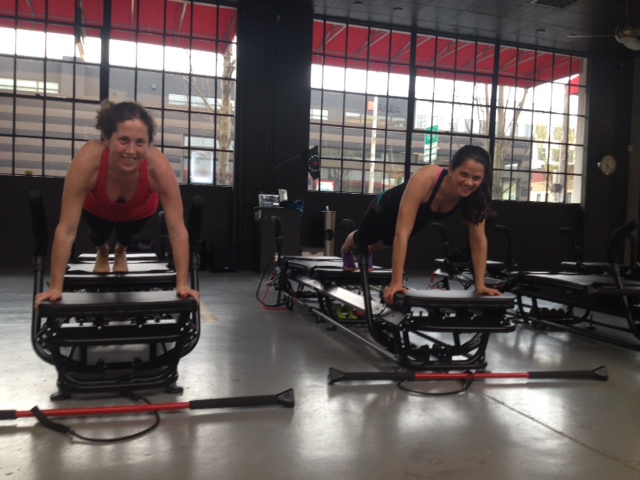We always include strength training in our running plans. We believe it is a key part of any successful plan. The one move we always include is the Single Leg Deadlift. It tones the hamstrings, the hips and the glutes. All three are needed to stabilize the body while running. Additionally, balancing on one leg reduces strength imbalance between left and right sides. Add this one move into every workout and your legs will feel stronger and healthier. Do 2 sets of 15 reps per leg. GO!
Sticking to your training plan when traveling
It can be challenging to stick with our training plans while traveling, for work and for pleasure. We usually recommend cutting back the miles so you can enjoy your vacation or not be overly stressed about fitting in a long run.
Meghan was just on a work trip for 7 days so she had to rearrange her training schedule to fit her work schedule. Here’s what she did to keep up her fitness and get her miles in. She was in Mexico City with a photographer so she was at the mercy of the light and the photographer’s schedule. While this got her awesome pictures, it didn’t leave a lot of time for working out. She decided to cut way back on her miles and focus on strength this week. Mexico City has terrible traffic so they walked a lot (5-8 miles a day) so she was conscious of how much her legs were doing.
The end of the race made for a perfect picture!
- Monday – travel day
- Tuesday – 30 min run on treadmill and 5 minutes of abs
- Wed – 15 mins of strength in hotel room
- Thursday – 20 min run and 10 mins of strength in hotel gym
- Friday – 20 min total body workout
- Sat – 20 min HIIT workout
- Sunday – 5.5 mile run (and she found a race!)
Traveling can be stressful so we always recommend going with the the least stressful option – finding a treadmill or cutting back on your miles.
Base Building. Staying in the Game.
Ever wonder what you're supposed to do before your half marathon or marathon race training plans actually start? The average runner is not constantly in race training (if you feel like you are, stop and talk to us about recovery!). This period in between recovery and race training is hard for a lot us who thrive off of structure and goals. For others coming back from an injury or time off from running, you might have the same question: How do you stay fresh and ready to dive into more technical demands of race training like intense hill and speed workouts and long runs? The answer? Do three simple things:
- ADD VARIETY TO 1 RUN PER WEEK
- BUILD UP TO 1, 90-MINUTE LONG RUN PER WEEK
- STRENGTH EXERCISES AT LEAST 2X PER WEEK
ADDING VARIETY:
What I mean here is vary your pace and vary your terrain at least once a week. You can be very structured about this or spontaneous depending on what works best for you and your lifestyle. Either way, start to incorporate faster intervals and hill work once a week. This can include progression runs where you get faster and faster each mile, short and long speed intervals (1 to 5 minutes), tempo runs, hill repeats or hill surges on a hilly run. For specific workout ideas, download our Base Training Plan.
THE LONG RUN:
In order to be race training ready, it's good to have the body accustomed to some longer distances so the long run isn't so taxing on the body. Accordingly, building up and maintaining the ability to run for 90 minutes is a good base line to settle in at during "spring training." Remember, as with any running routine, you want recovery weeks. So, every couple of weeks, drop your long run down to 60 or 70 minutes to give your body a break. Once you can do 90 minutes comfortably, start to challenge yourself on these runs either by harder terrain, faster paces in the middle or the end of the run.
TARGETED STRENGTH WORK
The majority of runners make just enough time in their day to get their run in. Maybe a few extra minutes for stretching . . . maybe. But, building a strong foundation during this phase is just as important as maintaining the frequency of your running. While training plans aren't taking over your life, this is a good time to really commit to strength work at least two times a week. Focus on a couple core exercises and a couple lower body exercises. Honestly, 30-minutes a week is a good start (2, 15-minute strength sessions). Do it. Check out our video library for exercise suggestions.
Would you like extra guidance on how these three principles play out in a base training training plan? Download our free Base Training Plan. Once you have a chance to review it, feel free to reach out to us with questions about how to make it your own. Base building is casual and carefree - this is not a time to stress about missed runs, but it is a time to start mixing things up!
The One Move Runners Need
by Meghan Reynolds
Ok, you might need more but this one move is great because it works so many muscles - your hips, glutes, hamstrings and core, with the added bonus of working your chest muscles. I like this move because it works multiple areas and is efficient.
Super Bridge Press
Begin laying on your back with a pair of 5-8 lb dumbbells in hands. Put both feet on a Bosu ball (or, use sofa cushions or stair step) and get in a bridge position. Keep your knees at 90 degrees, glutes engaged and shoulders on the ground. Lift your right leg straight up in the air as you perform a chest press. Keep you right leg straight up as you simultaneously do a bridge lift and a chest press (lift hips and straighten arms together, then lower). Repeat for 20 reps and switch sides.
Start Position
Lift your hips and arms together
I've been doing this move for the past week - 2 sets of 20 reps every other day and my hips and hamstrings are not as achy when I run. Do these first thing in the morning. I'll be sharing new moves every week - follow us on social media to see our recommended strength moves for runners.
Strength exercises we all need
If you are a client or follow our blog, you know we love our cross training - yoga, strength classes, spin, and any other fun class that is out that. I've been reminded of how important it is to running this past month. After coming off an injury and doing a ton of physical therapy work, I started running in mid February. I started off slowly - no more than 30 minutes, every other day. I was doing my therapy exercises and feeling good. Somewhere along the way, I started to slack off on the therapy exercises. I can't pinpoint it exactly but I think it was after I ran 6 miles pain free. I thought "I'm better!" And that equated to not having to continue my exercises - WRONG!
I'm still running pain free but after a few weeks of not really doing any strength (yikes - Jessica would scold me), I can feel it - little aches and pains, my legs are too sore after hills. So, I signed up for some strength classes and recommitted to doing my exercises. I do them 2x a week and go to a strength class 1x a week. For now, this is what works with my schedule and life. The results? I feel stronger on the hills and I'm now sore but in the right places!
If you need some ideas, here's what we recommend:
- Clamshells
- Bridge lift series
- Sit ups (with knees at 90 degrees)
- Squats
- Backward lunges
- Plank (30-60 seconds, option to move into side plank)
- Multiplanar single leg exercises
And, for those of you who need some extra motivation, a class is always a great idea. Find an instructor you like and a smaller class so you get the form correction.
Cross Training to Get a PR
Training for a PR in any distance race is a rewarding yet challenging endeavor. It can be tough on your body and mind. We have found that focusing on specific workouts and understanding how to recover and use rest days are the key ingredients to running a PR. Most training plans will have key workout days and rest days; what many plans lack is cross training. Understanding how to cross train and use recovery days will make you a stronger and faster runner.
We distinguish between two types of cross training activities: (1) Cardio, which is spinning, elliptical, bike intervals, walking, swimming, aerobics classes, and (2) Strength, Conditioning and Flexibility which includes Pilates, yoga, boot camp, and strength sessions or classes. Both types are important while training and for overall injury prevention and long term running health.
Cross training days are important because they help you help build aerobic fitness and muscle stability. By increasing overall aerobic fitness, you force the heart to pump oxygen through the body at a quicker rate. Over time, this makes your heart stronger, which enables it to deliver more oxygen to the muscles, and helps your muscles use oxygen more efficiently. Running is one of the best aerobic activities there is, however, just like your muscles, you need to switch up your cardio so your body can react and learn to work hard under all types of work. Muscle stability will help ward off injury and give you a much more solid base to increase speed. Running can overwork certain muscles, such as the hamstrings and quads, and essentially ignore major stability muscles including glute medius. Strength training brings more balance to your body.
Be careful to not overdue it on your cross training days. Too much intensity within a week can actually weaken your muscles. Classes are great because the instructor takes you through an array of work - hills or intervals, for example in a spinning class or full body strength workout in a boot camp class. If you workout on your own, it’s important to vary your cross training and make it counts towards strength, stability and fitness.Below, we have listed a few cross training ideas that will help elevate your training:
Spring Intervals
6-8 Sets of 30 seconds max effort speed intervals (ideally you are standing and the resistance is high). Recover at a very low and comfortable level for 2 minutes in between each sprint. Warm up and cool down for at least 10 minutes each. Do this only 1x a week.
Easy, Recovery Ride
30-60 minutes at an easy relaxed pace that is similar to your effort on an easy run. This is a great option to improve blood circulation the day after a hard run workout. You can do this workout up to 2x a week.
Strength Workout Do 2 sets of each exercise 2-3x a week. Avoid doing a lot of lower body work the day before a hill or track workout. (you can watch a demo of each exercise on our YouTube channel)
 Month 1: Plank (60 sec) | Side Plank (30 sec each side) | Lower Back Extensions - modified superman (60 sec) | Push-Ups (10-15x) | Bridge lifts (15x) | Bridge with Single Leg Walks (60 sec) | Single Leg Deadlift (30 sec each side) | Single Leg Calf Raises (15x each side) | Glute Press Up (30 sec each side) | Clamshells (12-15 each side)
Month 1: Plank (60 sec) | Side Plank (30 sec each side) | Lower Back Extensions - modified superman (60 sec) | Push-Ups (10-15x) | Bridge lifts (15x) | Bridge with Single Leg Walks (60 sec) | Single Leg Deadlift (30 sec each side) | Single Leg Calf Raises (15x each side) | Glute Press Up (30 sec each side) | Clamshells (12-15 each side)
- Month 2: Plank Walks (45 sec) | Side Planks (45 sec each side) | Single Leg Bridge Lifts (30 sec side) | Pushups (20x) Single Leg Deadlift (45 sec each side) | Single Leg Calf Raises (20x each side) | Glute Press Up (45 sec each side) | Clamshells (20
 each side) | Squat Jumps (30 sec) | Reverse Lunge (30 sec each side) | Lateral Lunge (30 sec each side)
each side) | Squat Jumps (30 sec) | Reverse Lunge (30 sec each side) | Lateral Lunge (30 sec each side)
Returning to the Trails After Pregnancy
By Jessica Green
It seems crazy to think back to this time last year - I had just given birth to my daughter and was in major recovery mode. At that time, all I could dream about was getting back on the trails in Forest Park, but I knew there was specific work to do before I laced up my running shoes and hit the trails hard. I knew this mainly because I am lucky enough to work with fitness professionals and therapists who taught me how to return to running the right way postpartum.
With targeted strength work, expert advice and a lot of patience, I'm running stronger and faster than I have in years. This week alone I hit the flat trails for speed, the hilly trails for a mid-distance run and am looking forward to a 20-miler this weekend which will include plenty of undulating trails. In the last month, I finally feel like I beat pregnancy!
A dear friend and amazing Pilates instructor, Frances Darnell, once told me that it usually takes her clients about a year of hard work to feel comletely like themselves again after pregnancy. She was right in my case. She also had a lot more to say in the article that I wrote in this month's Trail Runner Magazine, "Hitting the Trails After Pregnancy."
To all moms and moms to be, I highly recommend taking a look at the advice Frances and others offer in this article as you begin thinking about starting to run again after your pregancy. Here's a glimpse at the article if you don't have access to the magazine:
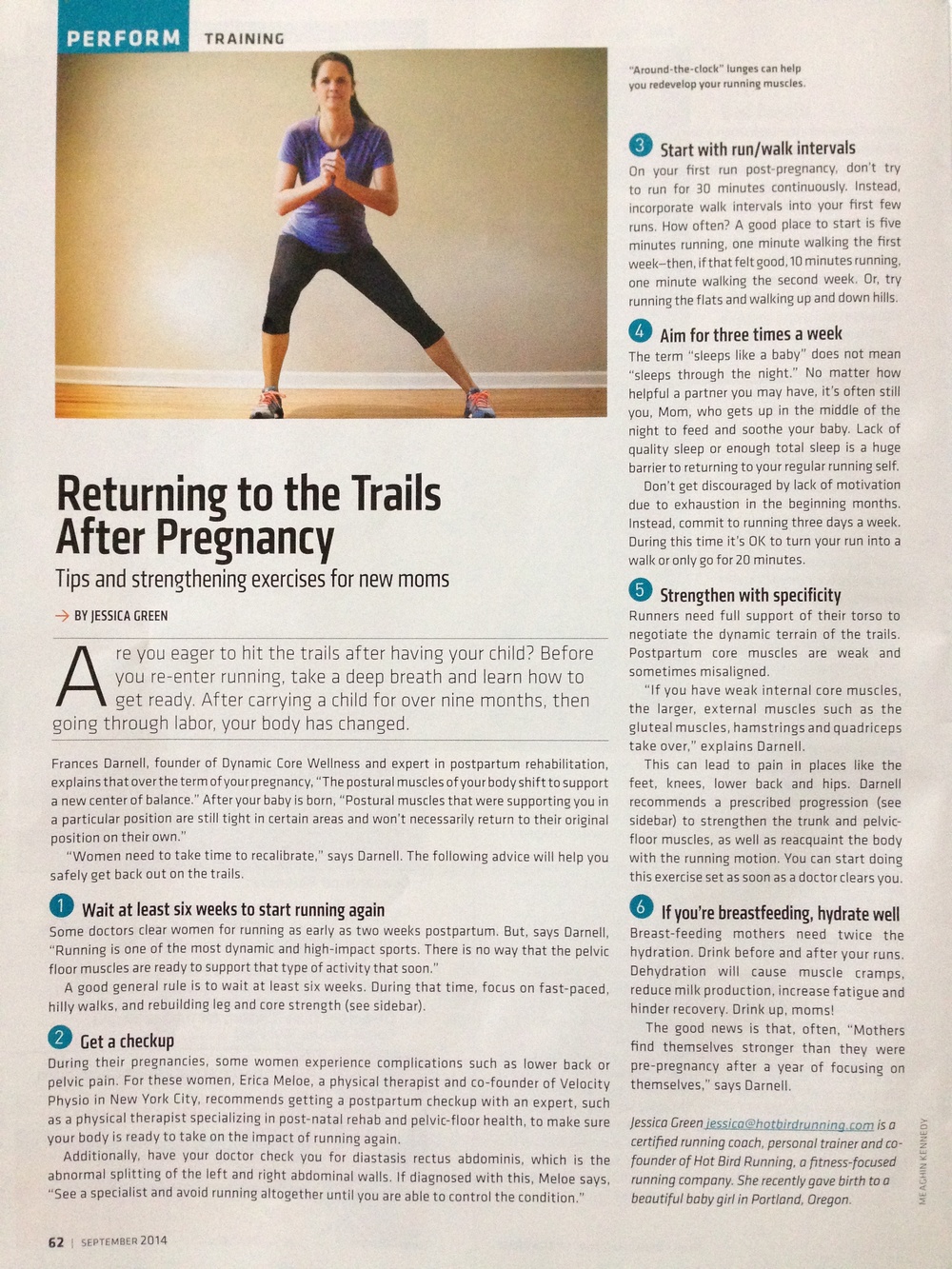
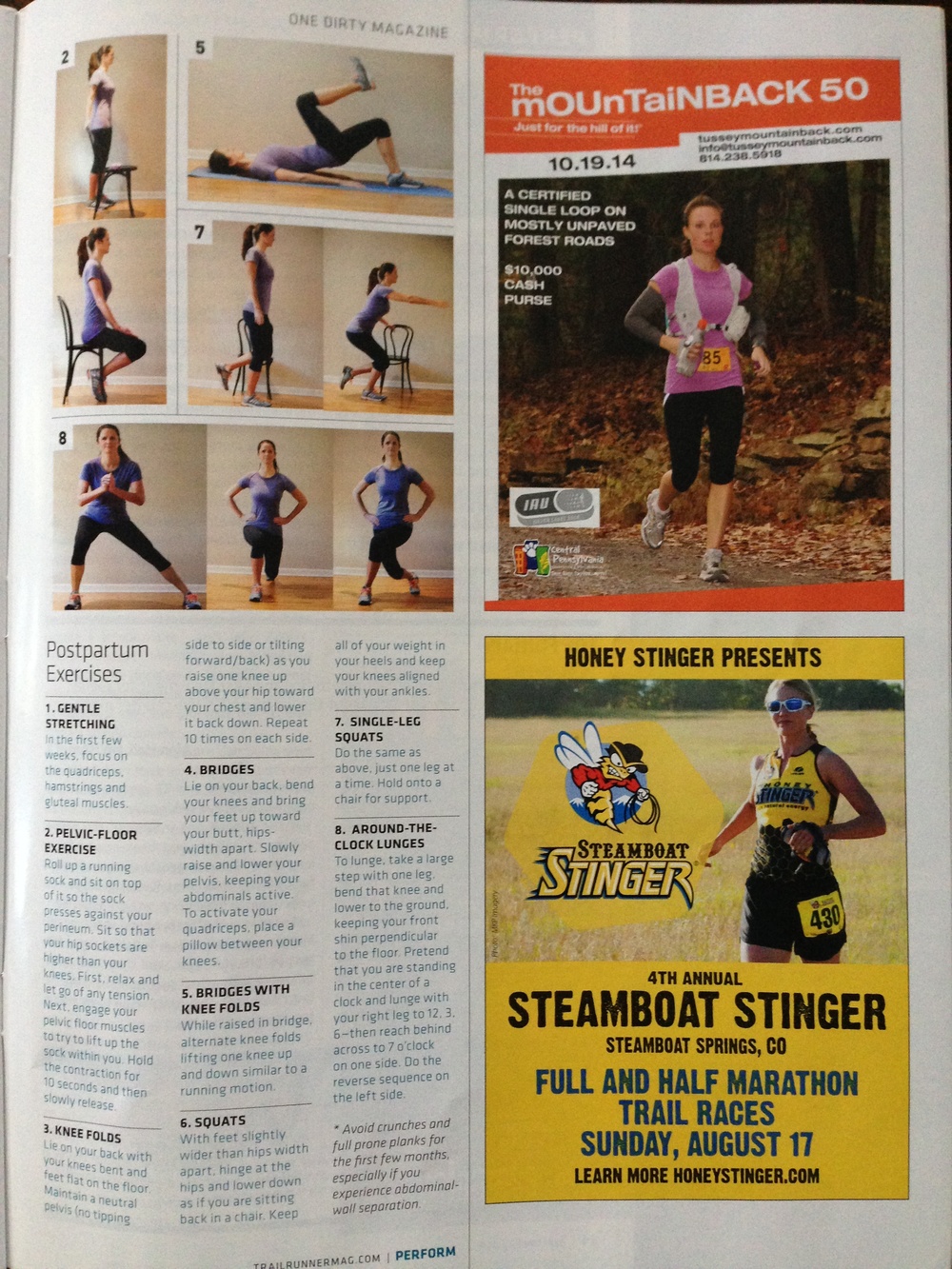
Raising the Barre
I regularly get asked by clients what they should do on days they aren't running. Cross-training is an essential part of the training process, and should not be neglected. While the answer "anything but running" is true, it's also not very specific. Strength training is important, and I also try to incorporate spin and yoga into my routine, but recently my favorite cross-training activity is barre. A Pure Barre studio opened up in my neighborhood a few months ago. Having never taken a barre class before, I didn't know what to expect. What I found was 55 minutes of tiny, isolated movements focusing on individual parts of the body, and a crazy soreness to follow the next day. I was hooked. I signed up for an unlimited month and fell in love. That was during my off-season. These days, while training, I like to hit a barre class 1-2x/week.
One thing I like about Pure Barre is that it is low-impact. Barre classes combine elements of pilates, ballet, and yoga along with an arm workout with light weights. This means that I can take a class on the same day as a shorter run, as it won't stress my body too much. It's especially good for core work. Runners often neglect the strength aspect of their training. Barre classes are a great way to get in the strength work and feel graceful while doing it. Plus I always like being in a class, the instructors motivate you to push yourself and embrace your strength. I highly recommend looking in your area to see which barre offerings are available to you!
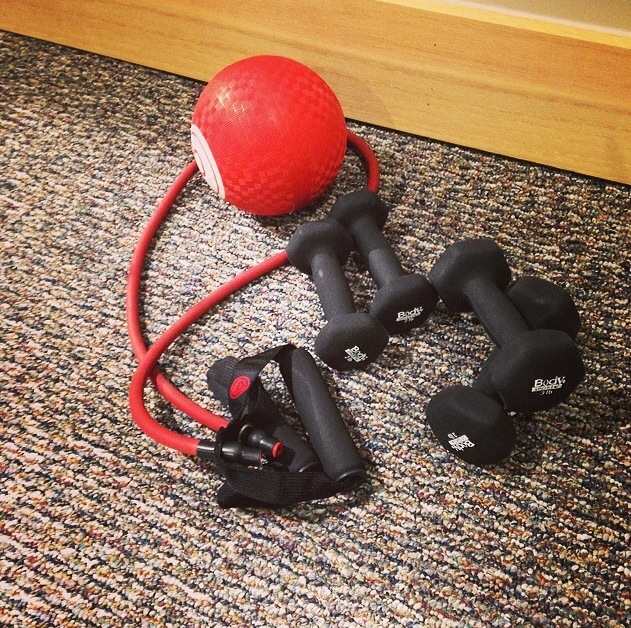
Melting away our running aches and pains
No matter how strong I am, how in shape I am or how much yoga I'm doing, I'm sore - A LOT! I sometimes feel like my hamstrings are made of lead. This feeling has been increasing over the past few weeks as my miles have ramped up and I'm doing track workouts. The soreness and pain diminish pretty quickly after running, it rears its ugly head during my runs. This has happened before and through trial and error, I discovered what relieves this soreness and pain (besides total rest): strength exercises and the MELT METHOD.
I still do yoga, foam roll and stretch but the combination of strength and MELT have relieved my body of so much soreness and pain, it's like a miracle. Seriously. Below details what I've been doing and why it helps.
Strength exercises - these exercises specifically target my hamstrings and glutes. I need to build up strength so they don't fatigue as quickly and are less prone to injury.
MELT Method: I use the actual MELT balls but you can use a tennis ball and golf ball. I do this after every run and in the mornings if my feet feel cranky. The reason MELT is effective for hamstring and glute issues is because the technique addresses dehydration. We have connective tissue all over our body, and in its simplest form, is what holds our muscles and organs in place. When this tissue is dehydrated, it doesn't move as well. When you bring back fluids to the tissues, you feel better and your body moves more easily. Check out this example of a 3 minute foot release from the MELT Method founder. Sometimes I just roll my feet on the large green roller (you can use a frozen water bottle). Do this for a week and I promise, you'll feel the difference.
An Apple a Day . . .
By Jessica Green
"An apple a day keeps the doctor away." The same can be said for a strength move a day for runners. Each week I preach about getting out there and doing your strength work and for the last two months I've been listening. It's made a difference. My lower back no longer aches from time to time and my hamstring doesn't feel as tight. I attribute a large part of this to my commitment to some type of strength work almost every day of the week.
What does this look like? In our training plans we often provide suggested strength routines for both core and lower body. These routines typically take 10-15 minutes to complete. That kind of time can be difficult to carve out of our busy lives day in and day out. What's important though is trying to - or at least remembering to think about strength training on a regular basis. For myself, this means getting down on the ground and actually doing something on a daily basis. On some days, it's only one series of planks/side planks/planks, but on other days it turns into a full blown 20-minute routine. Sometimes I'm in my pj's and other times a sports bra. No matter what it feels great to know that I've done something. The biggest benefit - I stuck to my routine and didn't let another day pass without some sort of strength.
Imagine going a week or even two without running . . . not good, right? Well, the same should be felt for two weeks of no strength. If you're looking for one move to get you through tonight, start with bridges with knee folds. They are great for pelvis stability, glute and hamstring strength and help prevent IT band issues.
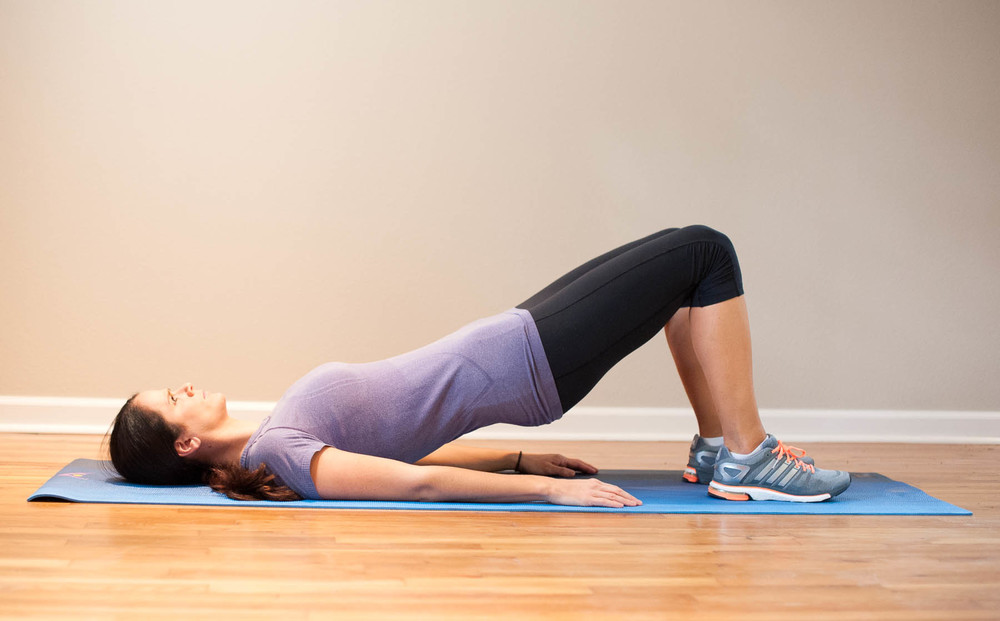
Lie on your back with your hands at your sides and bend your legs to bring your feet flat on the ground and about a hands length away from your buttocks. Raise your hips by firing your glutes and driving your heels into the ground. Lift up until you create a straight line from your hips to the knees. Maintain this position by firing the glutes and not flexing the lumbar spine.
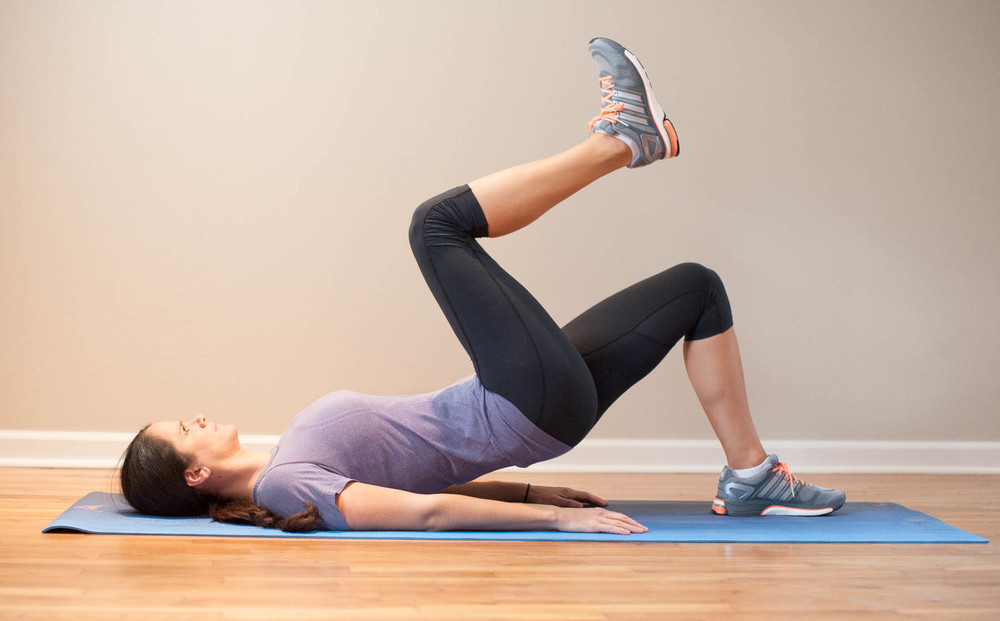
Once in bridge position, alternate bringing each knee up towards your chest keeping the leg bent at a 90 degree angle. As you raise and lower each leg, keep the pelvis steady and avoid rocking back and forth. Press your arms down into the ground with your palms facing down to help keep you stable. Continue alternating knee folds for 30-60 seconds. Repeat 2x.
Fleshman's Awesome Abs Routine
With recovery on our minds this month, I (Jessica) committed to "recovering" my pre-pregnancy abs starting this month. It's been almost 9 months since I gave birth and it's time to feel feel strong through my core again. There are no excuses at this point!
While texting my friend every night about my latest core routine triumph has been helping, I got another boost of motivation from the latest ab routine video by Lauren Fleshman, a kickass professional runner, fellow Oregonian and new mom as well, on Runner's World's website last week. The video is geared towards runners with a special focus on what recovering runner moms need in terms of core strength post-pregnancy. As with any post-natal abdominal exercises, check with your doctor first before diving into what Runner's World calls a, "Freaking Awesome Ab Workout." Once you're ready, I highly suggest getting on board the Fleshman Ab Train.
Strength Move of the Week: Squat to Leg Extension
Do you ever have the feeling that your legs are ahead of your upper body when you are running fast? Or, your legs are rotating around your pelvis as if your inner and outer thighs have nothing to do with your stride? One of the reasons for this is due to a lack of hip stabilty and balanced strength between your front muscles and side muscles in the leg.
If you are runner, you need hip stability and would probably also like inreased leg power to help you pick up the pace. One way to increase both of these is to implement squats with a leg extension into your routine. This move involves a slight twist on the regular squat to help strengthen abductors (outer thighs) and adductors (inner thights) as well as the gluteal muscles to promote hip stabilty. Try it out this week!
Strength Workout: Phone a Friend
By Jessica Green
Eight months have passed since I had my first child in August. For the last seven and half months, I attempted to do core work on a daily basis. I failed . . . miserably. Finally, I phoned a friend for some serious accountabilty. My friend, like myself, gave birth to her son in August and had grand plans to do core work a couple times a week, but was struggling to make it actually happen. On our runs we discussed this problem regularly with myself frequently complaining that I had zero core support on the downhills or when trying to pick up the pace. Both of us have fall marathons on the calendar and believe very strongly about the value of proper strength before and during our training. So, it was time to get serious. For the last two weeks, it's worked and I've done my core work almost every night.
I know that each week I present you with a new suggested strength exercise telling you it's as easy as one move a week. Well, sometimes we need more than a blog post telling us to do something. Sometimes we need a friend texting us in the middle of bathing our child that she just did her ab workout and it's time for you to do yours too. Perhaps it's the competitor in us that makes us do it. Or the real time reminder. Whatever it is, it's working!
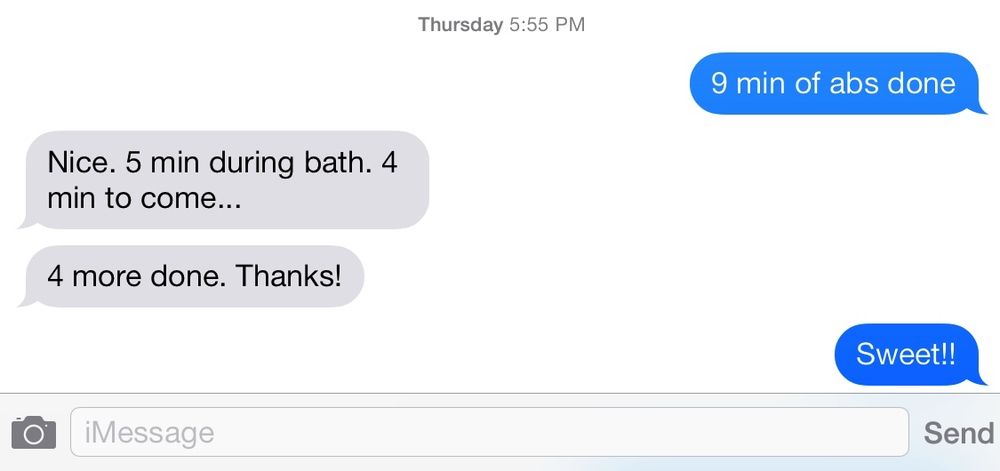
If you are struggling to make time for strength work (or any type of workout), then I challenge you to pair up with someone and start keeping tabs on each other this week. It works!
Strength Move of the Week: Clamshells
As running coaches who promote long term, injury-free running, strength work is always a part of our recommended weekly routine for every runner out there. So, where to start? Start with just one move a week and build from there. Hot Bird Running has you covered with our Strength Move of the Week!
Move of the Week: Clamshells
Fall marathon training is around the corner which means ramping up the mileage for many runners. This is a dangerous time for those prone to IT Band issues (you know who you are!). Here's a reminder to do your preventative work NOW rather than when the pain sets in and it's too late. Step one should be - start doing Clamshells. Clamshells improve the control and function of the gluteus medius which is a muscle that's usually weak in distance runners with ITBS. Clamshels also bring balance to the anterior and posterior hip muscles. As you do these, keep the hips stable and stacked on top of each other. Avoid twisting your lower back or rocking your top hip back and forth. Do 15 on each side.
How to Train for a 10k
If you want to crush your next 10k race, there are a few key things to remember.
1) Give yourself ample amount of time to train. I recommend about 12 weeks if you are a beginner or new to running.
2) Set up a log book to record your runs and your workouts. Aim to run three times a week and then have one of your runs be a longer run so that you gradually work up to the 10k mark which is 6.2 miles.
3) Strength train. Two key exercises that you want to implement during your training are squats and opposite arm/leg extension. So when you are doing a squat, you want to have your feet about hips width apart and you want to sit back as if you were sitting back onto a stool. Come down all the way or just do a modified one if that hurts your knees. Gradually work up to two sets of 25 squats, two or three times a week. The opposite arm/leg extension is great because it builds up your core muscles and gives you balance. To do the opposite arm/leg extension, come down into a tabletop position and extend your left arm out and your right foot back. Inhale and then as you exhale, bring your elbow and your knee together, hold for a two second count and then inhale and extend all the way back out. Do that ten times on each side. That exercise is safe and effective to do every day.
Strength Move of the Week: Calf Raises
As running coaches who promote long term, injury-free running, strength work is always a part of our recommended weekly routine for every runner out there. So, where to start? Start with just one move a week and build from there. Hot Bird Running has you covered with our Strength Move of the Week!
Move of the Week: Calf Raises
Why we love these? Calf raises feel like a miracle move sometimes. They are simple, can be done just about anywhere and help prevent shin splints, Achilles tendonitis, runner's knee, calf strains and more. Plus, they help power you up hills and pick up the pace in training and on race day.
We recommend single leg calf raises for maximum benefit because you are running on one foot at a time after all. To help with balance and proper execution, find a wall, chair or something to help you balance while you do the following:
1) Stand on a flat surface with feet hip width apart. Shift your weight onto the left foot, bending slightly at the knee to prevent locking. Draw the right knee up towards your right hip until the right foot is completely off the ground.
2) With all of your weight on your left leg, slowly lift your left heel off the ground and rise up on the ball of your foot as high as possible.
3) Slowly lower back down until the heel almost touches the ground and then rise back up on your toes again. Count to 3 on the way up and as you lower your heel back down and as you lower, emphasizing balance and control making sure movement is only in the ankles, not the knees or hips. Repeat this 15-20 times on each side.
Here's how it looks:
Our New Favorite Workout - Pyrolates
Jessica and I are always up for a new workout. We discovered Firebrand Sports in the fall. Pyrolates is one of the hardest classes we have ever taken. It's a total body workout that will kick your butt. It uses slow movements, body resistence and this god-awful moving machine to tone you up very quickly. Our arms and abs have never looked so good.
Each class combines strength training, cardio, endurance, core and flexibility – and not just in every class but also in each exercise. The class moves quickly and the depends on you being able to transition quickly and get into the next pose. After a few classes, we started to pick up the names of the poses but we still look at each other dumbfounded when it comes to some poses. French Twist? Bear? Thank god there are some people in the class who know what these names mean!
The megaformer/pyrolates class at Firebrand Sports in Portland is intense, hard, sweaty yet very rewarding. A lot of it comes down to your will power and your ability to push through difficult poses. The instructors are fun and friendly as well as harsh - they want you to get lower, push through the pain and find your limits.
If you have a Megaformer class near you, we highly recommend you check it out. It's a great addition to your strength or training routine.
Strength Move of the Week: Dynamic Warm Up
As running coaches who promote long term, injury-free running, strength work is always a part of our recommended weekly routine for every runner out there. So, where to start? Start with just one move a week and build from there. Hot Bird Running has you covered with our Strength Move of the Week!
Move of the Week: Dynamic Warm Up
Why we love this? Before diving into a strength workout or a run, you need to warm up the body. Specifically, you want to perform a set of exercises that increases blood flow to your muscles, increases your heart rate and awakens the nervous system to improve neuro-muscular control during your workout. The benefit? A significant decrease in the likelihood of overuse injuries and muscles prepared to maximize the impending workout.
Below is a video demonstrating our recommendation for a simple, yet effective, dynamic warm up to do before any run. Before beginning this routine, walk briskly, jog slowly or do some jumping jacks for a few minutes. Also, remember to ease into each activity progressively. For example, start with high knee marches and then transition into high knee runs. Lastly, as you do these exercises, actively control your movemens by contracting your muscles. This prevents forcing your joints to extend beyond their natural range of motion.
Monday Motivation - Planks
If you know us, you know we love our planks. Every training plan is loaded with planks, side-planks, knee to elbow planks, plank walks, etc. We tell everyone (who will listen) to do their planks daily. However, sometimes, you just don't have the motivation to do them. I'm there right now. I know I should do them, I know how good I feel when I do them daily but as my days and weeks get busier and busier, I find that my daily core exercises are the first to go. I still run, I go to fitness classes but my daily commitment to planks and core work is gone.
I'm recommitting to daily planks and to help, here are my top tips to recommitting to a daily practice:
1. Write it down - schedule it in your calendar or print out a calendar and put it on your refrigerator or post it at your desk.
2. Enlist your friends - make it a group activity! The girls I work with are all about staying healthy and fit. We created a weekly plank schedule and committed to doing it daily. We get some strange looks but people usually join in.
3. Build up - don't start off with a 4 minute plank. Give yourself a month and gradually build up. You'll be surprised how well it works and how strong you get by just adding 10 to 15 seconds a day to your plank.
4. Vary it - don't just do the same thing everyday. Variety will keep your body and mind alert. I created a plank video series. Check it out for videos for how to add variety to your plank workout.
Strength Workout of the Week: STAIRS!
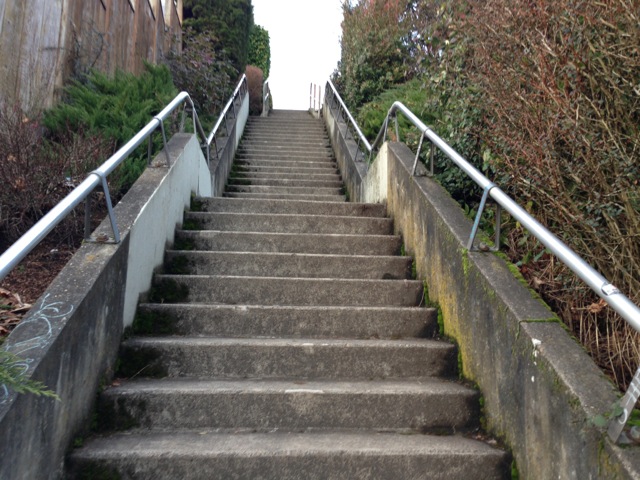 Improve your leg power and your running form with stair workouts. The best part is that a stair workout can be combined with a run for a cardio and strength combo workout by hitting up a series of stair climbs midway through your run this week. Portland, Oregon has sets of stairs hidden throughout the city (see above), but other places to look for a good set of stairs include your local high school or hilly parks.
Improve your leg power and your running form with stair workouts. The best part is that a stair workout can be combined with a run for a cardio and strength combo workout by hitting up a series of stair climbs midway through your run this week. Portland, Oregon has sets of stairs hidden throughout the city (see above), but other places to look for a good set of stairs include your local high school or hilly parks.
THE WORKOUT: Find a series of stairs that are regular height. After at least a 10-minute warm up, run hard up the stairs and jog slowly back down. You should be breathing hard at the top, but not keeling over. Next time up, skip a stair each stride. Alternate running up single steps and skipping a step for 10-20 minutes. If you want to get fancy, add in hopping up on one foot and then the other to your series.
*Concentrate on pumping your arms, keeping your head up, picking up your knees, landing lightly and pushing off with your calves as you run up the stairs. Use your core to stabliize your upper body as you bound upwards.
And remember . . . you OWN those stairs!











